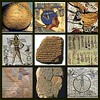"Now lies the earth all Danae to the stars,"
 Spencer TUNICK : - Melbourne, Australia
Spencer TUNICK : - Melbourne, AustraliaSo, who was Danae?
In the Greek Mysteries, Danae was a daughter of King Acrisius of Argos and Eurydice. Now, King Acrisius didn't have any male heirs. (Usual story, the guys need a male heir.) So anyway, he asked an oracle what to do. The oracle told him to go to the ends of the earth where he would be killed by his daughter's child. (Doesn't sound too hopeful for the king so far and I figure he might be rethinking the "male heir bit.") His daughter, Danae, was childless and because King Acrisius didn't like the idea of being bumped off by the child of his daughter, he shut her up in a tower, some say cave, so she couldn't well, you know, do the wild thing. But Zeus, the head god honcho came to her in the form of a beam of sunlight, and impregnated her. Others versions of the mystery say that Zeus came to her as a shower of gold. Soon after, their child Perseus was born. So Danae is the virgin mother of Perseus, and Zeus is his daddy. Who's your daddy!
So, what's the point about Danae? Not a lot really, except that I thought the reference might be a good hook to the article I am going to share with you today. Danae, is nearly always depicted in art as naked and waiting in anticipation, I guess, for that beam of sunlight which is going to impregnate her. No doubt she was pretty bored locked up and all that, so she probably had all sorts of time to laze around naked and dream of god superheros who would do the wild thing with her. Now, one night, she must have been lying there "all Danae to the stars," (naked), when in pops Zeus for a bit of sunbeam fornication. The rest is history. Well, not quite, but history and myth seem to intertwine quite often and most people don't seem to worry nor concern themselves with it.
To be "all Danae to the stars" is to be naked, or nude. (You may not be terribly interested in the Greek Mysteries or with poetry, but I bet that got your attention.) Well, I was watching television the other night and I happened upon a documentary exploring the works of the artist photographer, Spencer Tunick. Some of you may have heard of him before. He is a photographer who takes group photos of crowds of nude people. You can see some of his work here. The documentary was about his project where he travelled around the world convincing people from many countries to pose naked for him against or near well-known national monuments or places.
He prefers to use large groups of naked people so that they become like the paint on a picture. In other words, so that their bodies become part of the medium for his installations. What struck me about the documentary was the different cultural attitudes associated with trying to get a large number of people to be part of his photographs. I think the documentary mainly concentrated on work done during the early 2000s, when he wasn't perhaps as well known, because I notice after that, he had less trouble being able to harness a large group of participants.
The brits had no problem posing for the pictures, and a few hundred turned out to accommodate his artistic vision. Even though some people might consider the brits to be uptight, they seem to be not uptight when it comes to art. It was entirely different in Japan, where even though they may have communal bathing houses etc, he was only able to get about 4 people who were willing to pose nude for him. And in France, it was a similar thing, (at least during the filming of the documentary we are talking about), as he found it difficult to get more than one or two people willing to pose nude for him in front of the Louvre Pyramid. There was a kafuffle, and he was nearly arrested. The French may be liberated in their attitudes towards art, but no posing naked without permission. In Russia it was a similar story, there were strong cultural traditions against nakedness, so it meant that only a brave few turned up to pose in their naked glory. In Africa, ditto. In fact, in one long conversation with a woman in the documentary, she would only pose naked if money was exchanged hands. In Montreal, he had much more success, a few thousand turned up to have their picture taken. In some South American countries, he got a lot of people, but not many women. Many South American countries have quite macho cultures and according to some of the men interviewed, a woman would be lowering herself to pose nude at such an event. Which I can only interpret as, "It is ok for a male to show off his pecker."
But in Melbourne, Australia, approximately 4 thousand turned up in the rain, to bare their bums for art. The rain did eventually clear up enough so that some photos could be taken. I have to say that it warmed the cockles of my heart to see so many naked Australian bums praying to the god of sunshine. There were no reports of mysterious sunlight copulations. It must have been Zeus's day off. Or perhaps there weren't any virgins there! :)
Funny :)
![]() Spencer Tunick
Spencer Tunick ![]() nude
nude ![]() naked
naked ![]() art
art ![]() photography
photography ![]() installation
installation ![]() australia
australia ![]() melbourne
melbourne ![]() greek myths
greek myths ![]() danae
danae ![]() alfred lord tennyson
alfred lord tennyson ![]() 'Now Sleeps the Crimson Petal
'Now Sleeps the Crimson Petal ![]() zeus
zeus





















